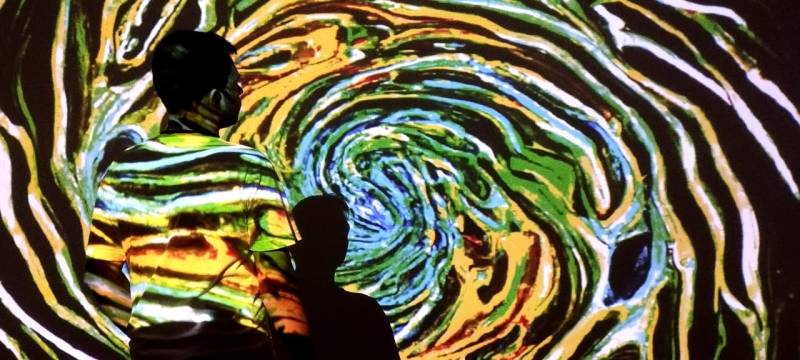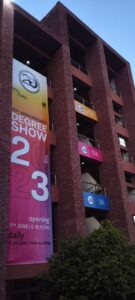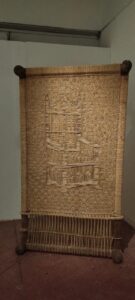
Much like a work of art, a beautiful equation has among its attributes much more than attractiveness – it will have universality, simplicity, inevitability and an elemental power.
To the contrary a postmodernist believes, “much like a work of science, a work of Art represents both more and less than a simulacrum of pleasure – it is foregrounded by the value relative to the value-maker, attests to multiple layers of possible meaning, is inevitable only in that it privileges the mores of a particular culture at a particular time in history and, within its shifting temporary context, it is ripe for continual reinterpretation and validation."
The dramatic contrast between these two visions of reality make manifest the extreme differences in the epistemological traditions which have underpinned and separated the two cultures of science and the Arts and humanities through much of the twentieth century.
Unlike its predecessors contemporary art is seen by many as an all-encompassing discipline instead of simply a style or a genre adhering to a dogmatic structure. Hence it allows for art not to be solely perceived as a linear entity, rather something ambiguous, something more amoebic in its shape as opposed to rigid and laid out. Contemporary art mirrors contemporary culture and society, offering teachers, students, and general audiences a rich resource through which to consider current ideas and rethink the familiar. It proves to be the binding force that fuses art with other disciplines/social institutions that are interrelated and interdependent and together compose the overarching social structure of society. As Kader Attia, acclaimed French-Algerian artist known for his poignantly radical social practice puts it “You can be transgressive politically without being in politics."
The work of contemporary artists is a dynamic combination of materials, methods, concepts, and subjects that challenge traditional boundaries and defy easy definition. Diverse and eclectic, contemporary art is distinguished by the very lack of a uniform organising principle, ideology, or some kind of -ism. In a globally influenced, culturally diverse, and technologically advancing world, contemporary artists give voice to the varied and changing cultural landscape of identities, values, and beliefs.
Curiosity, openness, and dialogue are the most important tools for engaging with works of art. Instead of questioning whether an artwork is good or bad, the study of contemporary art requires an open-ended methodology and an inquiry-based approach. Asking questions that ignite discussion and stimulate debate is an important first step toward appreciating and interpreting works of art that can defy expectation, may provoke strong responses, or contradict personal beliefs or societal values.
Bringing contemporary art into schools and communities enables educators to promote curiosity, encourage dialogue, and initiate debate about the world and the issues that affect our lives.
Contemporary artists address both current events and historical ideas. These references help educators and students make connections across their curriculum and support interdisciplinary thinking that forms the ethos of the School of Visual Arts at Beaconhouse National University led by Dean and renowned art practitioner Rashid Rana who believes contemporary art is part of a cultural dialogue that concerns larger frameworks, such as ideas about beauty, personal and cultural identity, family, community, and nationality.
As an artist from South Asia who developed his practice aligned with new media tools, Rana claims we aim to seek refuge either in the footsteps of the developed global north or the stylistic inventions of our magnificent, rich romantic past. A way out of this “insoluble dilemma of dichotomies" lies in the formation of new legacies and novel trajectories he suggests.
In celebration of BNU’s 20th anniversary, the faculty of Mariam Dawood School of Visual Arts and Design at Beaconhouse National University organised its largest annual degree show featuring the incredible works of 113 talented undergraduate students. For the first time since its creation in 2003, BNU Visual Arts department had on display the works produced by students belonging to the newly formulated Undergraduate Degree Programme namely “BA (Hons) IEDA –Interdisciplinary Expanded Design and Art” that aims to cover numerous fields of study through the lens of Visual Art. Outcomes of this programme included works by Tehreem Rizwan Qureshi, a virtual façade designer whose project dealt with reimagining facades of historical buildings gracing magnificent Lahore. She made use of elements of sound, light and movement by projecting patterns to transform the architectural façade of a pre-partition building.

Similarly Zuha Tareen breathed life into everyday objects by “performing autopsies” on them thereby emphasizing both “metaphorical” and “methodical” interdisciplinarity. She claims her visual scrutiny as “psychoanalysis through material exploration.” As a result her space took the form of a lab or a site of medical procedures with specimens and autopsy reports on display. The objects that underwent autopsies turned out to be assemblages imbued with an ethos of historic art movements of the 60’s such as Arte povera, Nouveau Realisme which primarily made use of borrowed objects and materials from the great detritus of the everyday with radical subversions and contrasting juxtapositions of the organic and industrial, functional with the nonfunctional, new with the old to weave together complex visual narratives through perplexing constructions.
Iman Asif Butt’s experiential design project comprised of immersive audiovisual experiences to examine the perception that transcends human consciousness: a study that focuses on the “unconscious” in light of the transformative therapeutic power of Art. She terms it “Cognitive Investigation”, a product of her collaborative research with a psychologist.
Fine Artists Mehvish Iqbal and Reyaan Hameed explored memories through the use of frames, employing a formalist approach towards image making. Mehvish’s stacked, glossy plastic 2D monochrome stencils of 3D objects created a compelling illusionary effect. The vibrant colors alluded to the post war movement of Pop Art that elevated the everyday and popular culture to the level of Fine Arts.
Reyaan Hameed’s nuanced approach to nostalgia on the other hand focused on the “window” as a portal that connects the past to the present. Recreating once functional windows in her ancestral home, she projected on the pristine white frames, images from her family archives in an attempt to emulate the overlapping nature of times: past and the present.

International scholar from Bhutan, Yeshi Choden’s meticulous treatment of a single material i.e plastic, testified to vigorous material exploration by the artist irrespective of medium. Hence her outcomes took forms of 2D imagery, a mammoth installation accompanied by a sweeping video work resembling a massive wave depicting the monumental scale of environmental catastrophe caused by the discharge of erroneous substances or energies that result in climate change and ecosystem degradation.
Audiences play an active role in the process of constructing meaning about works of art. Some believe that the viewer contributes to or even completes the artwork by offering his or her personal reflections, experiences, opinions, and interpretations. It are events like these that serve as vessels to communicate and engage with diverse audiences; in the process initiating dialogue and expanding their existing notions of Contemporary Art and Design. In exchange their presence and participation serves as a means of recognition and encouragement for both faculty and students. The degree show continues till June 25 2023.
To the contrary a postmodernist believes, “much like a work of science, a work of Art represents both more and less than a simulacrum of pleasure – it is foregrounded by the value relative to the value-maker, attests to multiple layers of possible meaning, is inevitable only in that it privileges the mores of a particular culture at a particular time in history and, within its shifting temporary context, it is ripe for continual reinterpretation and validation."
The dramatic contrast between these two visions of reality make manifest the extreme differences in the epistemological traditions which have underpinned and separated the two cultures of science and the Arts and humanities through much of the twentieth century.
Unlike its predecessors contemporary art is seen by many as an all-encompassing discipline instead of simply a style or a genre adhering to a dogmatic structure. Hence it allows for art not to be solely perceived as a linear entity, rather something ambiguous, something more amoebic in its shape as opposed to rigid and laid out. Contemporary art mirrors contemporary culture and society, offering teachers, students, and general audiences a rich resource through which to consider current ideas and rethink the familiar. It proves to be the binding force that fuses art with other disciplines/social institutions that are interrelated and interdependent and together compose the overarching social structure of society. As Kader Attia, acclaimed French-Algerian artist known for his poignantly radical social practice puts it “You can be transgressive politically without being in politics."
The work of contemporary artists is a dynamic combination of materials, methods, concepts, and subjects that challenge traditional boundaries and defy easy definition. Diverse and eclectic, contemporary art is distinguished by the very lack of a uniform organising principle, ideology, or some kind of -ism. In a globally influenced, culturally diverse, and technologically advancing world, contemporary artists give voice to the varied and changing cultural landscape of identities, values, and beliefs.
Curiosity, openness, and dialogue are the most important tools for engaging with works of art. Instead of questioning whether an artwork is good or bad, the study of contemporary art requires an open-ended methodology and an inquiry-based approach. Asking questions that ignite discussion and stimulate debate is an important first step toward appreciating and interpreting works of art that can defy expectation, may provoke strong responses, or contradict personal beliefs or societal values.
Bringing contemporary art into schools and communities enables educators to promote curiosity, encourage dialogue, and initiate debate about the world and the issues that affect our lives.
Contemporary artists address both current events and historical ideas. These references help educators and students make connections across their curriculum and support interdisciplinary thinking that forms the ethos of the School of Visual Arts at Beaconhouse National University led by Dean and renowned art practitioner Rashid Rana who believes contemporary art is part of a cultural dialogue that concerns larger frameworks, such as ideas about beauty, personal and cultural identity, family, community, and nationality.
As an artist from South Asia who developed his practice aligned with new media tools, Rana claims we aim to seek refuge either in the footsteps of the developed global north or the stylistic inventions of our magnificent, rich romantic past. A way out of this “insoluble dilemma of dichotomies" lies in the formation of new legacies and novel trajectories he suggests.
In celebration of BNU’s 20th anniversary, the faculty of Mariam Dawood School of Visual Arts and Design at Beaconhouse National University organised its largest annual degree show featuring the incredible works of 113 talented undergraduate students. For the first time since its creation in 2003, BNU Visual Arts department had on display the works produced by students belonging to the newly formulated Undergraduate Degree Programme namely “BA (Hons) IEDA –Interdisciplinary Expanded Design and Art” that aims to cover numerous fields of study through the lens of Visual Art. Outcomes of this programme included works by Tehreem Rizwan Qureshi, a virtual façade designer whose project dealt with reimagining facades of historical buildings gracing magnificent Lahore. She made use of elements of sound, light and movement by projecting patterns to transform the architectural façade of a pre-partition building.

Similarly Zuha Tareen breathed life into everyday objects by “performing autopsies” on them thereby emphasizing both “metaphorical” and “methodical” interdisciplinarity. She claims her visual scrutiny as “psychoanalysis through material exploration.” As a result her space took the form of a lab or a site of medical procedures with specimens and autopsy reports on display. The objects that underwent autopsies turned out to be assemblages imbued with an ethos of historic art movements of the 60’s such as Arte povera, Nouveau Realisme which primarily made use of borrowed objects and materials from the great detritus of the everyday with radical subversions and contrasting juxtapositions of the organic and industrial, functional with the nonfunctional, new with the old to weave together complex visual narratives through perplexing constructions.
Iman Asif Butt’s experiential design project comprised of immersive audiovisual experiences to examine the perception that transcends human consciousness: a study that focuses on the “unconscious” in light of the transformative therapeutic power of Art. She terms it “Cognitive Investigation”, a product of her collaborative research with a psychologist.
Fine Artists Mehvish Iqbal and Reyaan Hameed explored memories through the use of frames, employing a formalist approach towards image making. Mehvish’s stacked, glossy plastic 2D monochrome stencils of 3D objects created a compelling illusionary effect. The vibrant colors alluded to the post war movement of Pop Art that elevated the everyday and popular culture to the level of Fine Arts.
Reyaan Hameed’s nuanced approach to nostalgia on the other hand focused on the “window” as a portal that connects the past to the present. Recreating once functional windows in her ancestral home, she projected on the pristine white frames, images from her family archives in an attempt to emulate the overlapping nature of times: past and the present.

International scholar from Bhutan, Yeshi Choden’s meticulous treatment of a single material i.e plastic, testified to vigorous material exploration by the artist irrespective of medium. Hence her outcomes took forms of 2D imagery, a mammoth installation accompanied by a sweeping video work resembling a massive wave depicting the monumental scale of environmental catastrophe caused by the discharge of erroneous substances or energies that result in climate change and ecosystem degradation.
Audiences play an active role in the process of constructing meaning about works of art. Some believe that the viewer contributes to or even completes the artwork by offering his or her personal reflections, experiences, opinions, and interpretations. It are events like these that serve as vessels to communicate and engage with diverse audiences; in the process initiating dialogue and expanding their existing notions of Contemporary Art and Design. In exchange their presence and participation serves as a means of recognition and encouragement for both faculty and students. The degree show continues till June 25 2023.

